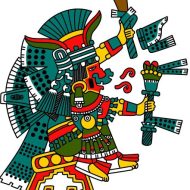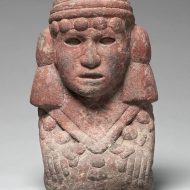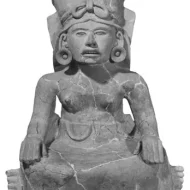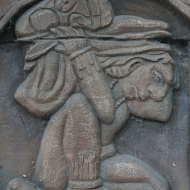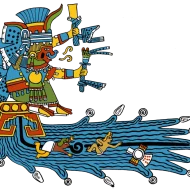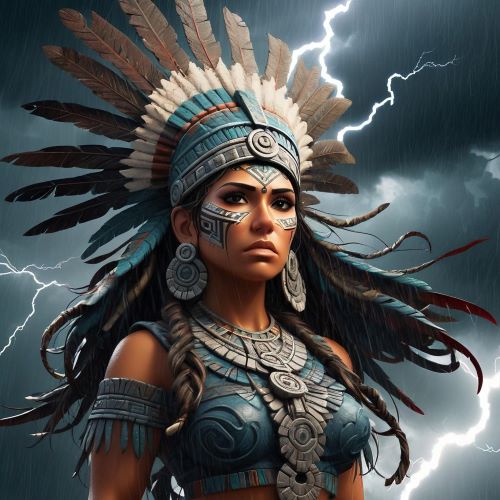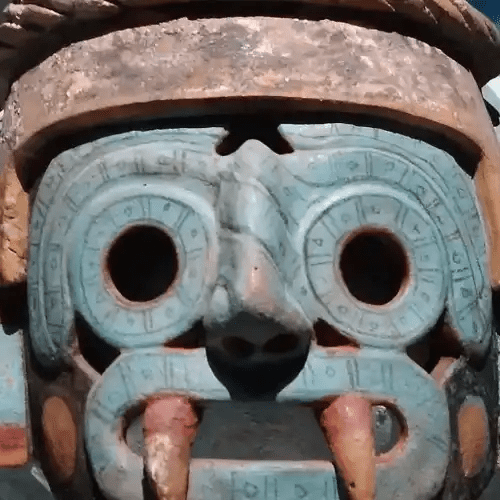Chalchiuhtlicue : The Water Goddess
Listen
At a glance
| Description | |
|---|---|
| Origin | Aztec Mythology |
| Classification | Gods |
| Family Members | Huitzilopochtli, Quetzalcoatl, Tezcatlipoca, Xipe Totec (Fathers), Tlaloc (Husband), Tecciztecatl (Son) |
| Region | Mexico |
| Associated With | Streams, Standing Water, Marriage, Newborns, 4th Sun |
Chalchiuhtlicue
Introduction
The Aztec goddess of water, known as Chalchiuhtlicue, was regarded as the Aztecs’ patroness of navigation. She was a notable deity, as she was known to protect newborn babies and childbirth.
The Aztecs believed that the world had seen five suns. The first four revolved around the elements, fire, air, water, and earth. The fourth sun was the creation of Chalchiuhtlicue, who released over 50 years of rain on top of the Earth to flood it. She then protected humanity by letting people swim as fish instead of drowning them.
The Aztec goddess known as Chalchiuhtlicue is said to be the mother of all rivers, lakes, and streams. People believe that she dresses in greens or blues, and she often displays a rattle in her hands. She was also known as the sun of the fourth age.
She was also responsible for ensuring that the waters were available for the harvest when needed, alongside Tlaloc. Water played a vital role in Aztec life, and this deity held a prominent position in the Aztec Pantheon.
Physical Traits
A unique headdress was worn by Chalchihuitliue. It features broad cotton bands that are trimmed with amaranth seeds, and large round tassels that fall from either side. She usually dresses in a skirt and wears a shawl that is adorned with tassels. She is also often seen sitting on a platform with a stream running behind her.
The Codex Borbonicus shows that Chalchiuhtlicue wore a white and blue headdress. In colonial and pre-Columbian books, she was depicted wearing a skirt made of blue-green fabric, which represented the abundance of water. A new-born child is often seen floating in the water as a symbol of water. She usually wears a noseplug and has black lines on her face. In Aztec portraits and sculptures, her images and statues are carved out of green jade or other natural stones.
She is sometimes seen wearing a Tlaloc-inspired mask. The Nahuatl word “chalchihuitl” means “drop of waters,” and it refers to the jade that is used in connection with the goggles that Tlaloc uses. In the Codec Borgia, she is wearing a headdress that features the same design as Tlaloc. Her nose ornament also has stripes and dots, and the serpent has the same markings.
Family
Although she was related to both the Tlaloques and Tlaloc, the deity’s relationship has been blurred by time. According to the Codex Ramirez, she was created by Huitzilopochtli, Xipe Totec, and Tezcatlipoca shortly after they created the world. It is believed that, following the world’s creation, Tlaloc and her consort were married.
Other names
The word “chalchiuhtlatonac” means “the jade skirt,” and her name is often interpreted as such. She was also referred to as Matlalcueye, who possessed the blue skirt, by the Tlaxcalans.
Powers and Abilities
As a water goddess, Chalchiuhtliue was able to control the welfare of rivers, lakes, springs, and oceans. People regarded her as the patron deity of sick and newborn children. She was also said to have positive and negative connotations.
When she was associated with Xilonen, who was a corn goddess, she was regarded as a source of irrigation canals. When she displeased, she would bring drought and empty canals, which would be paired with a dangerous serpent called Chicomecoatl. She is known for creating large storms and whirlpools, and she was also responsible for navigation difficulties.
The main Chalchiuhtilcue myth states that the goddess destroyed the previous world after ruling over it, which was referred to as the Fourth Sun. This occurred in the Deluge Myth, which ended in a different version in the Aztec universe. According to the Five Suns Legend, the various goddesses and gods created different versions of the world before the Fifth Sun.
The fourth sun, which was called Nahui Atl Tonatiuh, was ruled by Chalchiutlicue. There, the abundance of fish was a major feature of the world. After 676 years, all humans were turned into fish after Chalchiutlicue caused a cataclysmic flood.
Modern Day Influence
As a water goddess, Chalchiuhtlicue was associated with Tlaloc. During the month of February, various ceremonies were held to honor these deities. These were known as Atlcahualo, and the Aztecs would often sacrifice children on the mountain tops. The tears of these kids were believed to be good omens for rain.
Related Images
Frequently Asked Questions
What is lorem Ipsum?
I am text block. Click edit button to change this text. Lorem ipsum dolor sit amet, consectetur adipiscing elit. Ut elit tellus, luctus nec ullamcorper mattis, pulvinar dapibus leo.
What is lorem Ipsum?
I am text block. Click edit button to change this text. Lorem ipsum dolor sit amet, consectetur adipiscing elit. Ut elit tellus, luctus nec ullamcorper mattis, pulvinar dapibus leo.
What is lorem Ipsum?
I am text block. Click edit button to change this text. Lorem ipsum dolor sit amet, consectetur adipiscing elit. Ut elit tellus, luctus nec ullamcorper mattis, pulvinar dapibus leo.
What is lorem Ipsum?
I am text block. Click edit button to change this text. Lorem ipsum dolor sit amet, consectetur adipiscing elit. Ut elit tellus, luctus nec ullamcorper mattis, pulvinar dapibus leo.
What is lorem Ipsum?
I am text block. Click edit button to change this text. Lorem ipsum dolor sit amet, consectetur adipiscing elit. Ut elit tellus, luctus nec ullamcorper mattis, pulvinar dapibus leo.

